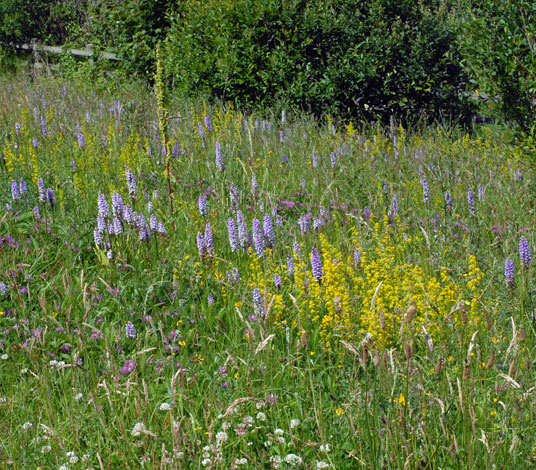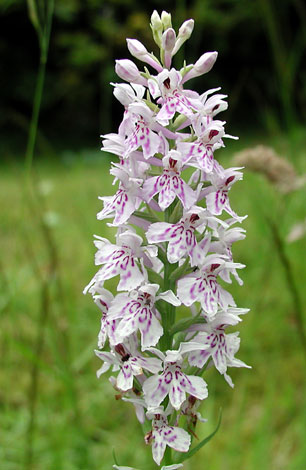Dactylorhiza fuchsii Common Spotted Orchid CC DD N


I remember the excitement many years ago when I first realised that the new plant I had discovered was an orchid. Being a bit of a gardener, I felt sure I could grow them at home and so returned later on to collect the seeds. I imagined them to be the size of sweet pea seeds. I was disappointed to find nothing but dust.
Reading about orchids I soon realised that they produce very small seeds with very little food stored (a little like fern spores perhaps) and that although the seeds can sometimes germinate, they can never thrive and grow without the help of a fungus upon which they are parasitic. Isolating the fungus is really difficult and even today there are species of Orchid for which the symbiotic fungus has not been identified. Now though we can propagate orchids in petri dishes with artificial substrates. Propagation of orchids is both an art and a science developed by orchid enthusiasts and the expert botanists at Kew.
Later on I found one or two friends in whose gardens orchids has simply arrived so imagine my delight when in 2001 the first Common Spotted Orchid appeared in our garden on an untreated grassy bank. The plant has grown stronger each year and the only nurturing it gets is my admiration. This was our orchid - it may not be wild in the sense of growing out in the countryside but it arrived here just as the wild ones would have.
2008: Our single orchid has now died but it produced flowers for five years and scattered seeds each year so perhaps another will appear sometime.
2010: For some reason we left the mowing of the flat lawn (our house is on the side of a hill and has sloping lands all round) until late. The Hypochaeris radicata (Cat's-ear) was just beginning to flower and looked very pretty in what was now becoming a natural wild flower meadow. Closer inspection revealed no less than four very small D. fuchsii plants in flower two of which had only a few blooms and looked as though they were in their first year. Perhaps they have been struggling to grow each year but have been mowed into oblivion.
2011: Knowing that Dactylorhiza fuchsii was growing in a part of the garden I declared it an SSSI and erected a little fence around the plot. Forty seven plants flowered in June. Forty seven !!
2012: Even in early March Dactylorhiza fuchsii rosettes were forming. The earliest ones appear to be the youngest plants - perhaps they are nearer the surface. After a month of counting rosettes the numbers stabilised at eighty three plants and although many have buds, they have yet to flower (May 2012). They are very variable. Some leaves are heavily spotted but others have virtually no spots at all. The flowers too varied last year from the typical spike similar to the ones illustrated in wild flower books to almost white ones with scarcely any pink markings on the petals or sepals
The name "orchid" conjures up ideas of rarity and exotic flowers but D. fuchsii is actually one of the commonest native plants. Except for some areas of high ground in the far north of Scotland it is found all over the British Isles and Ireland. Mine however are very special.
2013: There were ninety-five orchids flowering in my wild garden on 26th June 2013 and one of the interesting things is that the markings on the labellum vary so much. Most are distinctly purple with a white background like the one on the extreme left of the panorama composite photo but many are very pale. On some plants the spots on the leaves are distinct but in other plants they look washed out. A panorama of flowering spikes all taken on the same day in 2013 has been added below.





